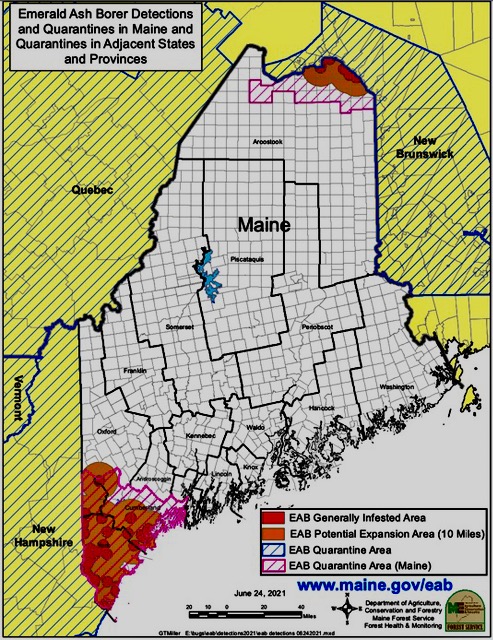| Chad Fierros, Stewardship Director, Royal River Conservation Trust |
As we enjoy some of the best weather of the summer, including sitting by the fire on cool nights, it’s a good idea to remind neighbors and community members about the importance to “burn local” when it comes to sourcing firewood. The transportation of firewood is one of the most common vectors for spreading invasive, destructive pests to a previously non-infested area.
One of the primary pests of concern is the Emerald Ash Borer (EAB), which has had catastrophic effects on ash tree populations south of Maine. Once EAB is introduced into an area, there is little time to react as ash mortality can be observed within three years and can be followed by over 90% mortality within 10 years (or sooner) if EAB populations reach infestation levels, which is commonly the case. Ash wood is valued by humans for many uses and is an important ecological component in our local watershed both in upland and wetland forest stands.


Part of the Royal River watershed is located in an area considered by the Maine Department of Agriculture, Conservation, & Forestry (MDACF) to be a potential expansion area for known EAB infestations located to our south and southwest. For this reason, most of the watershed – all of Cumberland County – is designated as an EAB quarantine area, which restricts the movement of items that may spread EAB out of the regulated area. Within and around the quarantine area, it is recommended to avoid transporting ash firewood (and other ash materials) more than five miles from its origin. Large ash trees, which are typically also the merchantable trees, have been found to contribute the majority of EAB individuals in a population, but EAB is also commonly present in small trees.

Hemlock Woolly Adelgid (HWA) is another forest pest that poses an extremely severe threat to our local forests. HWA has reportedly been observed nearby in coastal watershed towns this year, which means that taking precautionary actions to stop the spread of HWA is extremely important and time-sensitive. Similarly to EAB, HWA can spread very easily when transporting infected hemlock materials. It can also be spread through incidental contact with hemlock branches, since the adelgid egg masses are located on the underside of branches at the base of hemlock needles. Cumberland and Androscoggin counties are both under HWA quarantine.

HWA can cause mortality within four years of infestation or can present a pattern of steady decline year after year for 10+ years until mortality eventually occurs. The spread of HWA is limited by cold winter temperatures, but they have become less reliable in our watershed in recent years and are expected to continue along the same trend due to the effects of climate change in our area. It’s not uncommon to walk through forests of the mid-Atlantic and Southeast and observe that almost 100% of hemlock trees are in severe decline or already dead due to HWA. Hemlocks are among the most important and iconic trees in our watershed forests with beautiful, healthy stands distributed throughout our landscapes. Hemlock is very important for wildlife forage and winter cover and can function as keystone species by regulating shade and associated vegetative composition and temperature conditions, especially in riparian areas.

Both of these pests are particularly concerning because they attack otherwise healthy trees, as opposed to many other forest pests that require trees to be affected by an initial stressor before successfully attacking. The awareness and willingness of the public to take simple actions like burning local firewood can contribute significantly to responsible stewardship of our watershed.
For more information from the Maine Department of Agriculture, Conservation, & Forestry about Emerald Ash Borer and Hemlock Woolly Adelgid in Maine (including helpful signs to identify their presence), visit these sites:
— Emerald Ash Borer: https://www.maine.gov/dacf/php/caps/EAB/index.shtml
— Hemlock Woolly Adelgid: https://www.maine.gov/dacf/mfs/forest_health/insects/hemlock_woolly_adelgid_overview.htm






